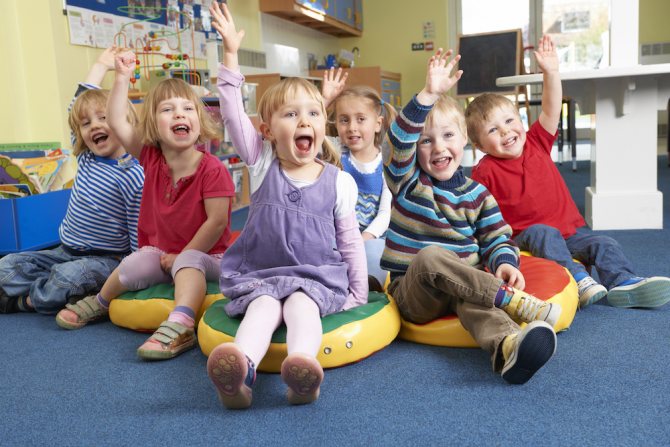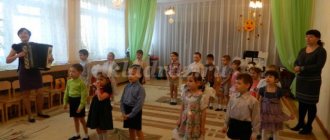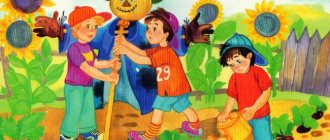The daily routine in kindergarten for all age groups of the kindergarten is based on SanPiN standards, and is designed for a 12-hour stay of a child in a preschool institution. The daily routine in a preschool institution is a strict, down to the minute, sequence of walks, meals, activities, games and daytime rest.
Thanks to such a regimented daily routine in kindergarten, the preschooler develops discipline, a love of order, and the ability to manage his own time, which will facilitate adaptation to school in the future.
In preschool institutions in our country, it is customary to divide children into groups by age. So, the early age group is from 2 to 3 years old; junior group - 3-4 years; middle group - 4-5 years; senior group - 5-6 years; preparatory group 6-7 years old.
However, regardless of the age of the preschooler, the daily routine in kindergarten begins at 7 am, when teachers receive children, and the “working day” in kindergarten begins at 8 am.
Approximate daily routine for a preschooler
7.00-8.30 - Reception of children 8.10 - Exercise 8.30 - Breakfast 9.00-10.00 - Classes 10.30-11.30 - Walk 12.00 - Lunch 12.30-15.00 - Day nap 15.30 - Afternoon snack 16.00-17.00 - Classes 17.00 - Pro party 18:00 - Dinner 19.00 - Care children home
As can be seen from the schedule, according to the recommendations of SanPiN, a kindergarten pupil is provided with four meals a day, with an interval of 4 hours between meals, there are also two walks, one of which is in the afternoon (the time of which may be reduced due to weather conditions), in addition, it is mandatory nap, and of course there is time for activities and games.
It is worth noting that there are slight differences in the daily routine of each group in kindergarten, which take into account the age characteristics of the children.
For example, if the duration of classes in the junior group of a kindergarten is only 10 minutes, then preschoolers of the senior and preparatory groups study for 20-30 minutes, which is close to school classes. The same applies to preparatory moments and getting ready - older children need less time to get dressed for a walk, or wash their hands before lunch.
Next, we will look at several important points from the daily routine in kindergarten in more detail.
ABC of the regime
There are rules in all areas of our lives, and they also exist in observing the regime. As we said above, there is a diet for preschoolers, physical activity, sleep, games, and activities.
Diet. If we are talking about proper nutrition, then the regime is most accurately followed in preschool institutions, so it is worth focusing specifically on the organization of nutrition in kindergarten:
- at least 4 times a day;
- a hot meal at least 3 times a day;
- according to daily caloric needs: breakfast 25%, lunch 40%, afternoon snack 15%, dinner 20%;
- according to the daily calorie intake: 5 years - 2000 kcal, 6 years - 2200 kcal, 7 years - 2400 kcal;
- by quantity - you should not give a portion larger than the child usually eats (it is better to add a supplement).
The menu should include meat and dairy products, bread, vegetables and fruits every day.
In terms of time, the mode is built like this:
- breakfast at 8-9 o'clock,
- lunch at 12-13 o'clock,
- afternoon tea at 15-16 hours,
- dinner at 18:30-19:30 hours.
Meal times should be the same on weekdays and weekends.
It is advisable that the last meal be an hour and a half before bedtime.
Mode of physical activity and rest. Every day a child makes many movements, so physical activity means not only physical education, but also active games, sports, movement and relaxation. And here, too, there is a regime that ensures proper physical development.
- The peak of physical activity should occur in the first half of the day.
- Weekly physical activity for children 5-7 years old is 6-8 hours per week, according to SanPiN.
- Morning exercises are required.
- Physical education classes in a preschool institution - 3 times a week: children 5 years old - 25 minutes, children 6-7 years old - 30 minutes.
- Outdoor active games while walking (in bad weather they are replaced by a full set of exercises indoors).
- Physical education minutes between mental activities.
- Exercising after a nap.
- Moderately active games on the second walk.
Moderate physical activity should be observed immediately before breakfast, before mental activities and in the evening before bed.
Sleeping mode. A proper sleep schedule helps restore your baby's mental and physical strength that was spent on the active part of his day. Not only his psycho-emotional state, but also his physical health depends on how a child’s sleep is organized. Healthy sleep means strong immunity. And now, in order.
- Sleep duration for preschoolers: 5-6 years old - 12 hours, 7 years old - 10-11 hours. But much is individual - depending on temperament and workload, the required time for sleep may increase.
- Morning awakening should occur at 7:00-8:00, it depends on biorhythms and family habits, but you should not wake up later.
- Daytime sleep in children 5-6 years old lasts 1-1.5 hours. At 7 years old, a baby may refuse to sleep, but active children need about 1 hour of sleep.
- Evening bedtime depends on the presence of additional physical or emotional stress. It is recommended that children aged 5-6 years go to bed at 20:30 - 21:00. At 7 years old it is possible to shift the time of falling asleep by half an hour.
Mode of exercise (mental activity) . Both kindergarteners and children who do not attend kindergarten are not deprived of developmental activities in preschool age. But like any other activity, the time and number of classes must be correctly distributed and systematized. In other words, the home regime should not differ much from the regime in preschool institutions. The organization of classes in the general daily routine is as follows:
In the morning after breakfast - two or three multidirectional classes. Duration of classes according to age: 4-5 years - 20-25 minutes per type; 6-7 years - 30-35 minutes.
If the walk is cancelled, you can add another creative activity or educational game.
Kindergarten classes
As mentioned above, the duration of classes depends on the age of the child. A lesson in the junior group lasts 10 minutes, 15 minutes in the middle group, 20-30 minutes in the senior and preparatory groups.
In these classes, the preschooler learns a lot of new things, begins to form his horizons, and becomes familiar with the basics of writing and mathematics. If the kindergarten is specialized, with a certain focus, then additional classes may be included in the schedule. Also, the schedule in the middle and senior groups may include additional thematic classes and developmental clubs.
In kindergarten, not only the time of classes is regulated, but also their distribution throughout the day. The schedule is drawn up so that children not only do not become overtired, but also make the most of their activity.
Thus, classes that require increased concentration are carried out in the first half of the day, between 9 and 12 hours, all others - in the afternoon, between 16 and 18 hours. Activities that require perseverance and attention alternate with outdoor games and gymnastic warm-ups.
In addition, the most complex subjects, such as the basics of mathematics and writing, and speech development, are scheduled in the first days of the week, when preschoolers are most alert; for the rest (music classes, drawing, etc.) the second half of the week is usually reserved.
We teach to study
This is where the biggest difficulty awaits parents. Children are used to it and love to play. But learning for them is something incomprehensible in principle, and therefore boring and unnecessary. In a group of peers, children study together, which is an additional incentive. In addition, experienced teachers know how to find an approach to children and interest them in the upcoming work. But how can you explain to your child at home what the point is in learning?
Most of us will start to scare the child with the fact that “ignoramuses, when they grow up, work as janitors or loaders.” To a child, such a prospect seems very distant and vague. And besides the fact that he will devalue the work of a loader or janitor for himself, such suggestions will be of no use.
The second option, and also not the best, is bribery: if you read it, you will receive a toy, sweets, or play on the computer. This approach will only create commodity-money relations between the preschooler and adults. The baby will not be interested in the result of his work. It will be important for him to quickly finish what is preventing him from having fun and get the desired reward.
How can you help your child accept the need for classes?
- Appreciate all your child’s achievements: both existing and upcoming ones. Teach it to teach, and not to satisfy your unfulfilled ambitions.
- Don’t cram as much knowledge into it as no one knows everything. First of all, take into account what is interesting to the child himself, comparing with the requirements for readiness for school.
- Do not compare your own child with others who are more successful - this will lower the child’s self-esteem and discourage the desire to learn. Compare with how he himself is progressing.
- You cannot buy the efforts of a preschooler with some benefits, just as you cannot force him to study as a punishment for wrongdoing.
- You cannot punish for mistakes or inability. Parents are helpers, mentors and advisers.
- Always praise your child for any successes, support him, show your pride in his successes and faith in his strength.
- Difficult tasks cannot be excluded. They are most useful for the development of the baby. Just show him that you are always ready to help.
- Stick to the established time of classes, observe age standards for their number per day and duration.
- Diversify your lessons with fun physical education breaks so that your child doesn’t sit too long and get tired.
The daily routine of a preschooler is aimed, first of all, at his development and preparation for learning. Therefore, it is so important to draw it up correctly and strictly adhere to it. This habit will help the child throughout his life. It will make him more confident, organized and productive.
Meals
The main meals in kindergarten are breakfast, lunch, afternoon snack and dinner, if the child is in kindergarten until 19:00.
In all preschool institutions, regardless of their focus, meals are scheduled at approximately the same time: at 8.00-8. 30 breakfast, 12.00-13.00 lunch, 15.00-15.30 afternoon tea, 18.00 dinner.
In the daily routine according to SanPiN, each meal is preceded by preparation: children wash their hands and sit down at tables. The time for this preparation is also regulated and reduced depending on the age group.
Guidelines when choosing a mode “for yourself”
A strict regime does not contribute to the development of a child in complete harmony with himself and the outside world.
A free schedule, on the contrary, is psychologically comfortable for the baby. Of course, in some situations it may be necessary to wake up your baby at a certain time. A good solution in this case would be to wake up in the REM sleep phase (active eye movements, body twitching, forced breathing). From the deep sleep phase (even breathing, no movement), the child will emerge dissatisfied, nervous and capricious. If it is difficult to put the baby to bed in the evening, parents need to make sure that by the desired bedtime he is tired from an evening walk with active games.
The individual characteristics of the baby, his biorhythms, character, temperament, as well as the needs and capabilities of the parents - at the intersection of these initial data, a reasonable compromise must be sought.
Without going to the extremes of a strict regime and a “no regime” regime, let’s talk about the advantages of a clear daily routine, because they still exist.
It has been noticed that a child who has a thoughtful, correctly drawn up daily routine:
- Cheerful and active;
- Balanced and in a good mood;
- Perceives and assimilates information better;
- Open to learning new skills;
- Socially active and friendly towards others.
An important argument in favor of the regime is the following observation: if a child adheres to a routine daily routine from an early age, it is later easier for him to adapt to the regime adopted in kindergarten and school.
Experts say that in the first years of life a baby is very sensitive to even small deviations from the established schedule. With a lack of sleep or increased physical and mental stress, his mood and behavior change. As the cerebral cortex matures and its functions improve, the child’s ability to adapt increases, but this does not mean that the daily routine can be canceled.
Maintaining a well-established daily routine at home helps the baby adapt to constantly changing environmental conditions more safely, calmly and without overwork.
If you decide to stick to the regime, when creating your daily routine, remember:
- The schedule should be flexible, reasonable and as focused as possible on the interests and needs of your child;
- The upper and lower limits of periods of wakefulness should be determined not by norms, but by the characteristics of your child’s particular nervous system, including its flexibility and performance;
- Sleep should be distributed throughout the day so that the baby’s nervous system receives complete rest;
- The periods of sleep, wakefulness, feeding, games and walks are established in such a sequence that they do not contradict each other, but, on the contrary, flow harmoniously into one another.
Walks and quiet time
These important components of the daycare routine are also age-appropriate.
Children from the early age group go for a walk earlier than others, at 9.00-9.30. The quiet hour has also been increased - babies sleep on average from 12.30 to 15.00.
Children from the senior group and the preparatory group go to a quiet hour at 13.00; their sleep lasts an average of 1.5 hours. They also have a shorter time to prepare for a walk - children at this age can already independently and quickly change clothes for playing in the fresh air.

However, regardless of age, quiet time in kindergartens ends at 15.00. After afternoon tea, the younger groups have a general education lesson; students from the middle and older groups are engaged in games or independent activities.
During the second walk, the children are gradually picked up by their parents. In winter, due to the fact that it gets dark quite early, the time for the second walk is reduced, and children are taken directly from kindergarten. Also, the walk may be shortened due to weather conditions: for example, frost or strong wind.
Choosing your approach to the regime
Both a free sleep mode and a clearly established one have their pros and cons. Each parent decides for himself what is best for him and his child. How to choose the mode that is optimal for you?
- Strict regime. The child sleeps, eats, plays and walks at strictly defined times. Thanks to such predictability, internal discipline is developed and the habit of time planning is formed. Not to mention the fact that it is much more convenient for parents, especially in the first, most difficult years of a child’s life. However, a strict regime does not take into account the individual characteristics of the child and does not always correspond to his biorhythms. In addition, in this case, deviations from the daily routine negatively affect the baby’s mood and well-being. At the psychological level, a strict regime suppresses the will and desires of the child, which is not very conducive to the formation of personal independence. Free regime. This regime develops as a result of observations of the child, his characteristics and needs. Since the baby already in the first months of life shows a preference for a certain time of waking up and falling asleep, the diet, walks and games are formed on the basis of this key indicator. Thus, parents select the optimal time for sleep, feeding and walking in accordance with the child’s biorhythms, and the daily routine, one way or another, is quite orderly.
The only difference from a strict regime in this case is that the daily routine is not built on the basis of average standards proposed by specialists, but based on the individual needs of a particular baby.
The child is formed as a self-sufficient, independent person who understands that his interests are respected, which means he has value in himself, and not through obedience. The baby grows up in a comfortable environment where his physical and psychological needs are not left unattended.
Such a schedule may cause some inconvenience for parents and other family members involved in caring for the child, and also does not facilitate smooth adaptation to kindergarten with a more strict daily routine.
Games, joint and independent activities
Games and shared activities are very important for children. They teach children to communicate, develop creative thinking and imagination. During joint classes, a group of children completes tasks proposed by the teacher, thus preschoolers learn to work in a team and develop communication skills.
A total of three hours are allotted for independent games and activities, which allows the child to devote time to his own interests. Children play during the remaining time in such a tight schedule: before morning exercises, before and after classes, during walks.
- share with your friends!
1 year old child's daily routine
The second year of a child’s life is marked by significant changes in mental and physical development: he continues to improve his speech skills and has already mastered walking, bending, squatting, and overcoming obstacles, although his movements are still poorly coordinated. Endurance is still low: the child gets tired quite quickly.
The baby is becoming more and more independent and enjoys mastering self-care skills: washing hands, brushing teeth, washing his face. All this requires giving the baby some time for self-care.
The performance of the child’s nervous system increases, which expands opportunities for cognitive and mental development. Simple developmental activities lasting a few minutes can already be included in the daily routine.
- Dream. The average daily sleep duration of a child after 1 year is 14–16 hours, of which 10–12 hours are spent on nighttime rest. Periods of wakefulness can already reach 3.5 - 4 hours in a row, daytime sleep is still two times a day - 1.5 - 2 hours each. By the end of the second year of life, the baby will switch to one-time sleep with periods of wakefulness lasting 4 - 4.5 hours. Readiness for one-time daytime sleep is obvious when the child can maintain a good mood all day, sleeps soundly, and does not become overtired in the evening. If the second one is refused sleep occurred too early, the baby will have noticeable mood swings, decreased appetite, bursts of hyperactivity, and moodiness. These signs may not appear immediately, but only after some time when fatigue accumulates. In this case, if the night's rest cannot be extended, it would be reasonable to return the second sleep for a while. Periods of wakefulness include walks, meals, games and rituals of grooming and preparation for sleep. We write more about sleep here.
Offer your baby healthy and tasty “Agusha Fall asleep” products, which are designed specifically for use before bedtime. This is live drinking yogurt with apple flavor and natural lemon balm extract, cottage cheese with strawberry, banana flavor and natural lemon balm extract, as well as porridge with prebiotics and cereals: milk-buckwheat and milk-rice with apple and pear, which will help your baby get into a healthy mood. and sound sleep.
- Walks. A child of this age takes walks twice a day, after breakfast and afternoon snack, lasting 1.5 - 2 hours. If the weather is good, it is important to keep your baby active, improving his motor skills and coordination. An afternoon walk, especially if it includes outdoor games, is essential for a good night's sleep.
- Games and activities. After 1 year of age, a baby’s attention span is still small; he cannot concentrate on one activity for a long time. Therefore, it is better to organize reading books, modeling from plasticine, exercises with insert frames and other developmental activities during the day so that they are short (10 minutes) and varied with other activities: walks in the fresh air and games (ball, cubes, pyramids, sorters and other baby-loved toys without a high intellectual component).
- Nutrition. The breaks between meals in babies after 1 year are approximately 3 hours, by 2 years - 4 hours. Breakfast should be served within an hour of waking up, the last feeding for the night should be no later than an hour before bedtime. At 1 year old, a child has 5 feedings a day, by 2 years old - 4 times a day. The feeding regime is structured in such a way that after feeding the child does not go straight to sleep, but stays awake for a while and only then falls asleep until the next meal. This rhythm of the day ensures a cheerful state and high cognitive activity, and most importantly, gradually accustoms one to understand the cyclical nature of the time of day, accompanied by certain rituals.
- Hygiene and rituals. Hygiene procedures are carried out in the morning, before afternoon tea and at night. Washing, washing hands throughout the day, brushing teeth in the morning and evening - with the help of parents, the baby gradually learns to cope with these activities on his own. Rubbing, showering, bathing - these activities still take place with the active participation of an adult. Bathing at night becomes part of the evening ritual of going to bed. Usually from 1 to 2 years of age, parents begin to gradually accustom the child to the potty. Even if the baby has not yet started using it for its intended purpose, potty sitting can be included in the list of daily rituals and offered after sleep, every 1.5 - 2 hours while awake, before a walk and upon returning from it. Prepare the child for bed It’s better in advance, stopping noisy games, dimming the lights, performing all the necessary rituals (planting on the potty, washing, bathing, a bedtime story and other preparations that you will develop over time and become traditional). To develop a routine, going to bed both during the day and at night should be done at the same hour: this way the child will form a conditioned reflex for a certain time. Subsequently, the baby will feel tired at bedtime and fall asleep easier.
Briefly about development standards
The age of 4 years is a time of restlessness, pranks, and outdoor games. The child asks a lot and tries to reason, sometimes revealing “pearls” that make the parents laugh so much. A four-year-old is actively making friends, establishing various social connections and trying to assert himself - for example, by demonstrating interesting toys or physical skills.
If we turn to medicine, then the development standards for 4 years are as follows:
- Speech. The child constructs sentences of 6-8 words, uses prepositions correctly, retells fairy tales, and knows 2-3 verses by heart. He can find an object by description, tell about the events of the day, knows his last name, first name and residential address. Speech arsenal – 1000–3000 words.
- Thinking. The child can easily count to 9, he matches sounds and letters, solves riddles and masters simple puzzles. He can assemble a construction set based on a drawn example, find the differences in the picture, and insert the missing puzzle pieces. The attention span increases to 5 minutes.
- Physical abilities. By the age of 4, coordination, dexterity, and fine motor skills improve. A child is able to string large beads onto a fishing line, draw a continuous line, or shade a simple figure. He can zip up clothes, untie shoelaces, and is good with a fork and spoon.
At 4 years old, a child feels the need to express himself as an individual. Sometimes his behavior leaves much to be desired. The parents’ task is not to scold, but to support and direct the child’s strength in the right direction.










